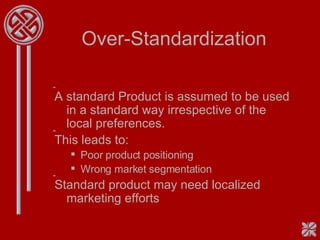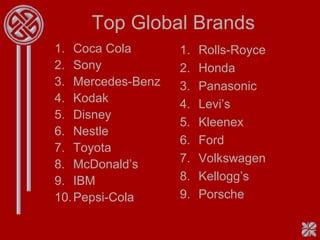Global Products
- 2. Definition Global Products are standardized products with a common brand name, with uniform features in all countries Eg: Gillette, Benetton Sweaters Regional products & regional brands are unique to a particular region. E.g: P&G’s Ariel, Honda’s City etc Regional products are latently global. They may become global as more customers know about it Marketing Global products is lot more complex than selling Regional Products
- 3. Advantages of Standardization For many products standardization is inevitable Uniform need for the product – Steel, Metals Economies of Scale & Scope. Benefit from a large market Key Benefits Cost Reduction – Economies of scale & scope Improved Quality Enhanced Customer Preference Global Customers Global Market Segments
- 4. Drawbacks of Standardization Off-Target or Wrong positioning in some countries Customers may have different needs Market segmentation is not always identical across cultures Lack of Uniqueness – Customers want to differentiate themselves with unique things Vulnerable to Trade Barriers – Global products need free trade Strong Local Competitors – Local competitors are better at adapting to local needs, making a global products vulnerable
- 5. Extent of Standardization In reality 100% standardization is rare Some features have to be localized Packaging, pricing etc Only the “Core Product” which acts as the foundation is standardized All additional features are standardized in varying degrees to meet local tastes E.g : Coca-Cola Standardization can involve use of Modular design
- 6. Factors Favoring Localization Cultural Demands – Local Tastes & preferences Even a “Globally standardized” product needs to be localized Compatibility Requirements Government Rules Local Climate & weather Local Technology standards
- 7. Pitfalls of Standardization Five Common Reasons why Standardized products fail Insufficient Market Research Over-Standardization Rigid Implementation Narrow Vision Poor Follow-up
- 8. Insufficient Market Research Insufficient Market Research leads to assumed market similarities, wrong demand estimations Local subsidiaries may become disenchanted Non-Acceptance of the product in local markets
- 9. Over-Standardization A standard Product is assumed to be used in a standard way irrespective of the local preferences. This leads to: Poor product positioning Wrong market segmentation Standard product may need localized marketing efforts
- 10. Rigid Implementation A standardized marketing program is not always beneficial Often Head-Quarters drives the standardization of all efforts and fails to notice local tastes and ignores better ideas from subsidiaries Standardized strategies increases overall sales growth but lowers ROI & ROA
- 11. Narrow Vision Increased Standardization leads to a myopic view of the local markets Local subsidiaries fail to learn from other subsidiaries of the parent Knowledge sharing and knowledge transfer becomes limited, leading to duplication of efforts, lost opportunities & profits
- 12. Poor Follow-up Launching Standard Global products world wide is a complex task Often firms do a poor job on following up on efforts and results from other subsidiaries Local Subsidiaries may not have the required resources to support the global product
- 13. Challenges of Global Products Its difficult to maintain a global product line History : Existing local products M&A: Integration of product lines is tough Local Preferences differ Distribution Channels are different Manufacturing Capacity Constrains Colgate has been quite successful in developing a long line of global products
- 14. Globalizing New Products Successful New products can be Globalized if the factors for its success can be Globalized Often times factors for a products success in not clearly understood More than 50% of global new products fail Market orientation & commitment of senior management is a must Asian markets need a higher level of technological sophistication, marketing synergies and longer commitment
- 15. New Product Success Factors Some of the common success factors are: Relative Product Advantage – Advantage over existing alternatives Synergy with the existing products Degree to with the new product is innovative Market orientation & Management Commitment Intensity of competitive reaction. If more number of competitors react, lesser is the chance of success Compatibility of the new product with existing infrastructure
- 16. Speed of Diffusion Speed at which a new product is introduced into other countries is termed Speed of Diffusion Speed of Diffusion depends on: Relative Advantage Compatibility with existing systems Complexity – How easy is it to use? Trailability – How easy is it to try a new product Observability – Ability of potential customers to observe the benefits of the new product Cosmopolitianism - Hetrogeneity slows down product adaptation
- 17. Global Brand Management Global Brands needs Global brand management Brand has Brand value and Brand Equity Coca-Cola brand is worth $69 Billion Intel Brand is worth $35 Billion Brand Equity is the present value of the net revenues the brand can be expected to generate over time Brand Equity depends on intangibles like Awareness, Knowledge, attractiveness – Brand Stature Differentiation, Relevance – Brand Vitality Brand Value is off-books but affects how Brands are managed
- 18. Advantages of Global Brand Demand Spillover Marketing efforts in one country can create demand on other countries. TV, Internet etc Global Customers Global customers often demand a globally standardized products Scale Economies Global Advertising, Standardized packaging can cut costs
- 19. Brand Portfolio Consumer goods makers usually have a portfolio of few global brands and several local Brands Less than 10% of brands are global In 2001, Study by ACNielson found only 43 global brands in consumer packaged goods Typically Brands are managed in a Brand Hierarchy, Global/Corporate brand at the top and local brand next E.g: Honda Accord, Intel Pentium, Sony Vega TV Global Brands are managed by the parent. Local brands are managed by subsidiaries Brand Extensions is done to introduce a new product
- 20. Brand Globalization Potential Not all local brands can become global. Here’s a checklist to see the brand fit: Does the brand name make sense outside the country? Does the brand suggest a country association? Can the brand name registered abroad? Is there synergy with existing Global Brands? Can a new Global Brand be Justified? Does the regional brand offer tough competition to global brands in that region?
- 21. Implementing Global Brand Implementing a globalization strategy raises few issues: In the globalization product based involving product entry into new markets? Is the product category unique to the company? Can the local brand names be replaced with a global brand name? E.g: Nokia brands all its telecom products as Nokia, even replacing brand names of acquired companies
- 22. Implementing Global Brand Can Local Brands be replaced without affecting market share? E.g: Electrolux maintains a host of local brands to retain its local customers Does replacing a local brand has a significant impact on the product? E.g: Budweiser in Europe, Thumbs up in India Does replacing a local brand affect the local competitiveness in the local market? Local Brands tend to be strongly associated with local culture & offers a higher competitiveness than global brands
- 23. Top Global Brands Coca Cola Sony Mercedes-Benz Kodak Disney Nestle Toyota McDonald’s IBM Pepsi-Cola Rolls-Royce Honda Panasonic Levi’s Kleenex Ford Volkswagen Kellogg’s Porsche
- 24. Replacing Local Brands Several standard brand Changeover tactics are: Fade-in/fade-out : Global brand is first associated with the local brand then the local brand is slowly faded out Endorsement Branding : Use a strong local brand to introduce a global brand Eg: Acura by Honda Double Branding : Local-Global brands or Old-New brand together Summary Axing : Simply drop a local brand & introduce a Global Brand
- 25. Counterfeit Products Strong & Successful Global brand names attracts counterfeiters. Counterfeit product is more common in high end fashion products Eg: Gucci, Ray-Ban etc Counterfeit or fake products are now seen in chemicals, computers etc Extensive, sustained operation is needed to fight fake goods, often government help is needed
- 26. Closing Thoughts Globalization involves global products and global brand names Global products is standardized to an extent to gain economies of scale & scope but localized to meet local requirements Global Brands are few in number and require global scale brand management New Global brands can be developed with substantial effort & commitment Changing local Brand names is not easy & requires extensive resources Counterfeit products is a major threat to established Brand names


























